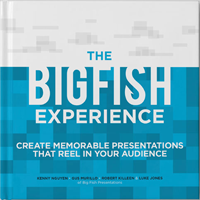Don’t Panic! Here’s Your Presentation Emergency Cheat Sheet

Life happens: deadlines are pushed, meetings pop up and, sometimes, you have to be ready to present at any given time. You could be given a lot of time to prepare or no time. Your boss could drop a surprise presentation on you, and it’s your job to be able to handle it. For many people, presenting on the spot can be the biggest challenge when it doesn’t have to be.
Our CEO, Kenny Nguyen, has been in countless situations where he only had a 15-minute window of preparation. One in particular was on the subject of effective presentations. Kenny only had an hour to prepare, so he decided to divide his time in two ways: 30 minutes of content creation and 30 minutes of sectional rehearsal with one full run-through. He used that strategy to pull off a great presentation. So, from this experience, here’s an emergency rehearsal cheat coming to your rescue. This method worked for Kenny, and it might work for you.
Before you start, make sure that you know your material and the audience you’re presenting to. Whatever information you have or don’t have, your main focus is to know what you’re trying to accomplish with this presentation. Gather the information you need to do this and then start organizing everything. Just remember not to panic and overload on facts or statistics. Keep it simple and clean. To get started, organize the information you do have into the following:
Opener:
Main Point 1:
Main Point 2:
Main Point 3:
Recap of Points
Closing Call to Action
First of all, you need an opener, supporting content, and a conclusion with a call to action. An easy way to remember this is the “Rule of Threes.” Audience members are more likely to remember information that’s sectioned off into three parts. These should be the main points you want the audience to take away from the presentation – points that go along with your main objective.
Now that you’ve got a basic outline, it’s time to fill it with content. For the opener, it’s always good to start off with a story that you can relate to the topic you will be presenting on. Stories help draw in the audiences’ attention and make you, as a presenter, more relatable. The story then leads into your first point. Sum it up in a couple words, list details you will touch on, and lead into the next point. The same goes for the second and third points. End your presentation with a recap of everything you’ve talked about and tie it all together with the story you started with. Last but not least, is making sure you end with time for questions and answers, as well as a call to action. After filling in your information, your basic outline should look more like this:
Kenny’s Outline:
Opener: Story
Main Point 1: Storytelling
What are the elements of a good story (hero, villain, suspense)?
Main Point 2: Design
What are the principles of design (has to be theories as no slideshow is provided-can potentially make audience laugh with the irony)
Main Point 3: Delivery
How body language, passion, and tone can impact audience
Recap of Points
Closing/Call to Action: Quote/Questions
Don’t worry so much about writing a script and memorizing it, because the best presentations are unscripted. Talk it out. Go through the outline and practice the flow of thoughts and words you will say.
So, after his speedy preparation, Kenny gave a great presentation that was warmly received. This could be you if you follow this format. It’s always a challenge when a surprise presentation is thrown your way. But, as always, you want to be prepared, and this cheat sheet will help you do just that.
Like what you’ve read? There’s more where this came from if you subscribe to Big Fish Presentation blogs.




Share your opinion.